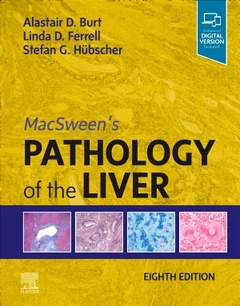MacSween's Pathology of the Liver (8th Ed.)
Auteurs : Burt Alastair D., Ferrell Linda D., Hübscher Stefan G.

Shares the knowledge and experience of a "who's who list of experts in the field of hepatobiliary pathology, led by editors Alastair D. Burt, Linda D. Ferrell, and Stefan G. Hübscher.
Features more than 1,000 high-quality, full color illustrations, providing a complete visual guide to each tumor or tumor-like lesion.
Discusses advances in molecular diagnostic testing, its capabilities, and its limitations, including targeted/personalized medicine.
Incorporates the latest TNM staging and WHO classification systems, as well as new diagnostic biomarkers and their utility in differential diagnosis, newly described variants, and new histologic entities.
Includes relevant data from ancillary techniques (immunohistochemistry, cytogenetics, and molecular genetics), giving you the necessary tools required to master the latest breakthroughs in diagnostic technology.
Provides you with all of the necessary diagnostic tools to make a complete and accurate pathologic report, including clinicopathologic background throughout.
Directs you to the most recent and authoritative sources for further reading with a comprehensive reference list that highlights key articles and up-to-date citations.
An eBook version is included with purchase. The eBook allows you to access all of the text, figures and references, with the ability to search, customize your content, make notes and highlights, and have content read aloud.
Chapter 1. Structure, Function, and Responses to Injury
Chapter 2. Cellular and Molecular Techniques
Chapter 3. Developmental and Inherited Liver Disease
Chapter 4. Disorders of Iron Overload
Chapter 5. Fatty Liver Disease
Chapter 6. Viral Hepatitis
Chapter 7. Other Viral and Infectious Diseases
Chapter 8. Autoimmune Hepatitis
Chapter 9. Bile Duct Diseases
Chapter 10. Diseases of the Gallbladder
Chapter 11. Vascular Disorders
Chapter 12. Drugs and Toxins
Chapter 13. Tumours and Tumorlike Lesions
Chapter 14. Transplantation Pathology
Chapter 15. Liver in Systemic Disease
Linda Ferrell, M.D. is a liver pathologist, Professor of Pathology, Vice Chair of Clinical Services, and Director of Surgical Pathology at UCSF. She specializes in the diagnosis of liver disorders such as: benign liver tumors, cirrhosis, hepatitis B, hepatitis C, hepatocellular carcinoma, vascular lesions, metastastic cancer to the liver, liver transplantation, nonalcoholic fatty liver disease (NAFLD) and nonalcoholic steatohepatitis (NASH).
Professor Stefan G Hubscher graduated from Birmingham University in 1979 and has worked and trained there ever since. While his main clinical work has been in liver pathology, he also has strong interests in hepatic, biliary and pancreatic malignancy.
Date de parution : 12-2022
Ouvrage de 1134 p.
21.5x27.6 cm
Thèmes de MacSween's Pathology of the Liver :
Mots-clés :
Alastair D. Burt. Linda D. Ferrell. Stefan G. Hubscher. MacSween's Pathology of the Liver. MacSween's. metabolic liver disorder. inherited liver disorder. developmental liver disorder. infectious liver disorder. chronic cholestatic liver disorder. chronic autoimmune liver disorder. pediatric cholestatic liver disorder. drug/toxin-related hepatitis. hepatitis. vascular liver disorders. transplantation pathology of liver. liver tumors. hepatic disorders. developmental/congenital pancreas disorder. developmental/congenital biliary tract disorder. inflammation of gallbladder. inflammation of extrahepatic biliary tree



